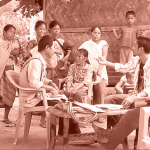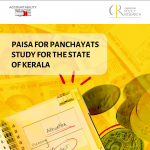
The 2 Big and Emerging Ideas on Accountability
15 January 2020
The Cutting Edge is an exclusive series by the Accountability Initiative featuring insights from world-renowned scholars, and ideas that can spur innovation.
Dr. Jonathan Fox is a scholar of global standing, known for his work on citizen participation, transparency and accountability. He directs the Accountability Research Center, an action-research incubator. He had a wide ranging conversation with team Accountability Initiative, when he spoke of pathways to accountability in governance, and the role of citizens in accountability. Below, you will find excerpts from this invaluable discussion.

1. Making research on accountability practice-oriented
Accountability, citizen participation and impact:
We’ve long considered the government’s responsiveness as an outcome of accountability, yet there are many possible drivers of government responsiveness that don’t involve a scriptural definition of accountability. For instance, if the government makes a decision like a fuel subsidy cut that leads to messy protest, and then the government decides to go back on it – is that policy change an example of accountability? It’s certainly a response. But are all responses to pressure necessarily “accountability?” That could be “conceptual stretching.”
As long as accountability relies on social accountability efforts in which citizens have to defend themselves, only a minority in the best case would be able to do that. People would be too busy taking care of the kids, or making a living. One could make the argument that the responsibility to fix the state is on the citizens and that’s a lot much to ask. We’re all doing the best we can, but the ideal system is for the rule of law to function, to have institutional checks and balances, plus mechanisms that actually address grievances, and access to legal advocates in order to navigate the system unbiased.
We’re in this difficult position of normatively valuing participation – yet voice alone can take us just so far (on the importance of institutions that can respond with voice and ‘teeth,’ see). For most people, most of the time, active participation isn’t feasible nor will it produce results that we seek. For example, in terms of schools – in what society do parents fix the schools? Other than the most upper class communities, 95 per cent of the society are completely excluded. One might wonder where the expectation that parents could ever have the power to do this come from? It’s a puzzle. You understand why the impulse [to empower parents in decision making], but we need to be realistic – it’s [also about] centuries of bureaucracy and social exclusion – which official school management committees are not equipped to address.
It [also] comes back to the impact question: how do we [research groups and CSOs] push back against unrealistic donor expectations that we’re going to overcome centuries of repression with a few meetings. It is really a problem! We’ve been socialised to buy into this. It’s ‘our problem’ if we can’t produce measurable results in a short timeframe. It’s their problem! There are limitations of expecting citizens to do all the work. It’s hard to make that sustainable. This is where I’ve been most recently exploring and encouraging a focus on positive outliers.
The Positive Outlier Approach:
We need to seek lessons from “positive outliers.” That’s where we’re going to learn the most, instead of only homogenising measures of impact. As long as we’re relying only on averages of large samples, we will render invisible the breakthroughs, and end up concluding that reform initiatives doesn’t work. The real question is why do accountability reforms ever work [even if it is] 15 per cent of the time, in certain blocks and districts? We need to then see how it worked in these places? What was different? [This approach] is relatively new to this field [accountability studies].
This was the research approach I took in the 1980s without realising and giving it a name. Who decides whether interventions are failures? I studied a top-down government reform supposedly to encourage autonomous oversight, which all academics assumed would never work. Yet there was this long march in this system by post 1968 generation cadre of reformists, who ended up creating a meaningful “opening from above” in food policy by promoting unprecedented, scaled-up freedom of association. In most regions this initiative was blocked or captured, just what one would expect – yet it “worked” in a third of the regions involved. That was a surprise. Only grassroots activists or inside reformers were aware that regional breakthroughs were happening [that time]. By conventional criteria of “what works,” that reform failed because it was blocked in 2/3rd of the country, yet for millions of people it represented a major breakthough for autonomous, scaled-up collective action.
2. Accountability in practice
On preventative and reactive approaches to social accountability:
Most social accountability work is exclusively micro, [and is] not [about] power shifting. This relates to one of the big questions – where is the synergy between preventative and reactive approaches? That’s the first big conceptual question that has extremely practical implications. The preventative approach reduces the opportunities and likelihood of accountability failures. Some of the ways in which information is categorised misrepresents or under represents the problem, which makes the problem invisible. It actively renders invisible where the problems are/or what does that mean in terms of an alternate proposal? What needs to change?
The difficulty of development practitioners to contextualise in translations:
When you’re working in other languages, you can seek ways of describing good governance goals that don’t have the baggage of ‘audit’ culture that the term accountability has come to take on. What’s the version and not an awkward literal translation [of a document or piece]. The term ‘whistleblower’ until about 1970-71, did not mean what it does today. Its contemporary meaning, to refer to insiders who put the public interest ahead of their own careers, was politically constructed. Are there existing terms in multiple languages that you can repurpose? Are there new terms that you can invent? [For more on this issue, see.]
I am most struck by the amount of data that both public interest groups and the government collect, that is never used. The billions and billions of hours filling out the 22 registers [by Anganwadi Workers] that they can’t even pay attention to the kids. The amount of data gathering in this machine that uses such a miniscule fraction of it – the labour that is wasted is tragic. This is particularly invisibilised and normalised and taken for granted. It’s considered so normal to fill out forms after forms, and then it gives social audits a bad name when the AWW is caught in front of everyone because there’s a paperwork discrepancy in Register X. Is it really that bad? Do you want to bring them to tears?
I think studying power structures is fundamental, as a broader concept to frame studying how the state actually works.
How do public officials justify to themselves and others what they’re doing? Insider knowledge is the best source for opening up the “black box” of how the system really works, but outsiders can also use research methodologies that involve immersion, like institutional ethnography, or political ethnography, which go beyond interviews. One of the puzzles is that there’s no how to guide, we looked and didn’t find a non-academic manual for applied researchers on how to do political or institutional ethnography.
There’s a dire need in the field for practitioner-oriented researcher to learn how to do this. Much of the academic literature, many of the academics who write about it, end up privileging their own interpretative and ideological agendas, without helping others to figure out how to apply the methods.
Institutional ethnography can be very academic and that’s one of the many reasons why applied researchers don’t use it.
On grievance redress studies:
The level of research on grievance redressal mechanisms – on how they actually work – is pathetic! I’m sure the accumulated experience of everyone in this room is much richer than any of the few academic articles that have been published on it. So, there’s a huge gap. It’s important to lift up this knowledge. My question is – who is going beyond a reactive approach? [For instance] as was recently reported in Rajasthan, community rights defenders reported that they had been cut out of a programme and reported: ‘I didn’t get the money, I used the [information access] system, I found out they thought I was dead, I was able to fix it.’ That’s a brilliant and evocative case of real world use of the system.
There’s so much potential to use public information [on government performance] proactively, not just the usual fishing expedition but to say you, with your [research] experience you could come up with very promising lines on an investigation where you have a very good sense of what the data mines.
Public service delivery through Information, Communication and Technology models:
I was involved for about a year and a half in a comparative study of governmental response to grievance redressal (digital), and we came up with a conceptual paper for the 2016 World Development Report. The book is fully open source, it’s called ‘Civic Tech in the Global South’. For this purpose, we were only looking at dedicated governmental platforms. The study raises the question – what were the incentives from inside the government to respond? What can be learnt from the patterns of complaints and concerns to inform a proactive, preventative strategy? We found that online complaints platforms helped those agencies that were already run by managers who were committed to responding to citizen concerns. We did not find cases where the complaints filed changed the managers’ incentives and turned them around.
One key question to ask about governmental online complaints systems is – do they have the systems for tracking citizen complaints and concerns? If so, who has access to them? Is there a tracking system for the senior officials or hopefully the public can see the flow of a complaint or concern in the system? I say this because there are many systems that do not track, and if you cannot track, you can’t tell whether it [the grievance] was addressed. It seems simple but it’s not often when there are internal governmental tracking systems. There’s no proactive disclosure.
This piece has been edited for clarity.
Edited by Avantika Shrivastava and Avani Kapur.
Transcription by Cearet Sood.





